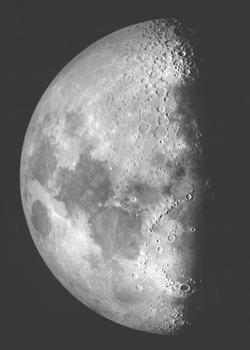Thu, Apr 10, 2008
LADEE To Launch In 2011
 NASA is preparing to send a small
spacecraft to the moon in 2011 to assess the lunar atmosphere and
the nature of dust lofted above the surface.
NASA is preparing to send a small
spacecraft to the moon in 2011 to assess the lunar atmosphere and
the nature of dust lofted above the surface.
Called the Lunar Atmosphere and Dust Environment Explorer
(LADEE), the mission will launch before the agency's moon
exploration activities accelerate during the next decade. LADEE
will gather detailed information about conditions near the surface
and environmental influences on lunar dust. A thorough
understanding of these influences will help researchers understand
how future exploration may shape the lunar environment and how the
environment may affect future explorers.
"LADEE represents a low-cost approach to science missions,
enabling faster science return and more frequent missions," said
Ames Director S. Pete Worden. "These measurements will provide
scientific insight into the lunar environment, and give our
explorers a clearer understanding of what they'll be up against as
they set up the first outpost and begin the process of settling the
solar system."
LADEE is a cooperative effort with NASA's Ames Research Center
at Moffett Field, CA; Goddard Space Flight Center in Greenbelt, MD;
and Marshall Space Flight Center in Huntsville, AL. The total cost
of the spacecraft is expected to be approximately $80 million.
Ames will manage the mission, build the spacecraft and perform
mission operations. Goddard will perform environmental testing and
launch vehicle integration. The mission will be established within
Marshall's newly created Lunar Science Program Office. Marshall
will draw upon experience gained from managing a larger suite of
low-cost, small satellite missions through NASA's Discovery and New
Frontiers Program.
LADEE will fly to the moon as a secondary payload on the
Discovery mission called Gravity Recovery and Interior Laboratory
(GRAIL), which is designed to take ultra-precise gravity field
measurements of the moon. Current plans call for the GRAIL and
LADEE spacecraft to launch together on a Delta II rocket and
separate after they are on a lunar trajectory. LADEE will take
approximately four months to travel to the moon, then undergo a
month-long checkout phase and begin 100 days of science
operations.
LADEE is one of many activities to support lunar exploration
planned by NASA's Science Mission Directorate in Washington. Last
year, NASA also established a lunar science institute at Ames.
Research teams will address current topics in basic lunar science
and possible astronomical, solar and Earth science investigations
that could be performed from the moon. In addition, NASA is
preparing for scientific investigations following the planned
launch later this year of the Lunar Reconnaissance Orbiter (LRO).
After a 30-year hiatus, LRO represents NASA's first step toward
returning humans to the moon.
More News
Aero Linx: Model Aeronautical Association of Australia MAAA clubs are about fun flying, camaraderie and community. For over 75 years, the MAAA has been Australia’s largest fl>[...]
Touchdown Zone Lighting Two rows of transverse light bars located symmetrically about the runway centerline normally at 100 foot intervals. The basic system extends 3,000 feet alon>[...]
“Discovery and innovation are central to our mission at Virgin Galactic. We’re excited to build on our successful record of facilitating scientific experiments in subor>[...]
How To Get A Story On Aero-TV News/Feature Programming How do I submit a story idea or lead to Aero-TV? If you would like to submit a story idea or lead, please contact Jim Campbel>[...]
Student Pilot Reported That During Rotation, “All Of A Sudden The Back Of The Plane Kicked To The Right..." Analysis: The student pilot reported that during rotation, “>[...]
 ANN's Daily Aero-Linx (05.02.24)
ANN's Daily Aero-Linx (05.02.24) ANN's Daily Aero-Term (05.02.24): Touchdown Zone Lighting
ANN's Daily Aero-Term (05.02.24): Touchdown Zone Lighting Aero-News: Quote of the Day (05.02.24)
Aero-News: Quote of the Day (05.02.24) ANN FAQ: Contributing To Aero-TV
ANN FAQ: Contributing To Aero-TV NTSB Final Report: Cirrus Design Corp SR20
NTSB Final Report: Cirrus Design Corp SR20



